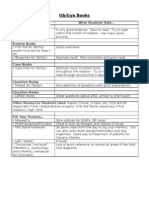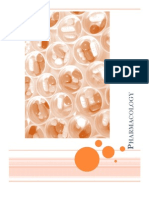Mksap 16
Mksap 16
Uploaded by
Wade BullockCopyright:
Available Formats
Mksap 16
Mksap 16
Uploaded by
Wade BullockOriginal Description:
Original Title
Copyright
Available Formats
Share this document
Did you find this document useful?
Is this content inappropriate?
Copyright:
Available Formats
Mksap 16
Mksap 16
Uploaded by
Wade BullockCopyright:
Available Formats
MKSAP 16
Study online at quizlet.com/_ed7p9
1.
2.
3.
4.
action of BAFF
mediates the maturation and survival of
immature B cells to antibody-secreting
plasmablasts, and its levels are elevated
in patients with SLE and Sjgren
syndrome
acute vs chronic
inflamm or
noninflamm
oligoarthritis
Acute inflammatory oligoarthritis by
gonorrhea or rheumatic fever. Chronic
inflammatory oligoarthritis by
spondyloarthritis or a connective tissue
disease. Chronic noninflammatory
oligoarthritis is usually caused by
osteoarthritis.
advantage of
febuxostat over
allopurinol
approved for patients with mild to
moderate kidney failure
adverse effects of
abatacept
increased risk of lymphoma and lung
cancer as well as flares of COPD
adverse effects of
allopurinol
rash, bone marrow failure, hepatic
failure, and Stevens-Johnson syndrome
adverse effects of
uricase and
rasburicase
highly immunogenic and is not an
option for chronic use.
adverse events
related to
cyclophosphamide
leukopenia, anemia, increased rate of
bacterial and fungal infections,
hemorrhagic cystitis and bladder
cancer, lymphoma, and other (longterm) malignancies
agents often used
in treatment of RA
in pregnant
Hydroxychloroquine and sulfasalazine
ANCA-associated
vasculitides
granulomatosis with polyangiitis (also
known as Wegener granulomatosis),
microscopic polyangiitis, and ChurgStrauss syndrome
13.
14.
15.
5.
6.
7.
8.
9.
10.
11.
12.
arthrocentesis
counts suggestive
of septic arthritis
greater than 50,000/L
corticosteroidsparing or
maintenance agent
in lupus,
vasculitis, and
polymyositis
azothioprine
cyclophosphamide
and pregnancy
never used unless life of mother is at
stake
16.
17.
18.
19.
20.
21.
22.
different
manifestations of
GCdepending on
blood vessel
involved
Cranial vessel involvement includes
jaw claudication (due to ischemia of
the masseter or temporalis muscles),
scalp tenderness, and temporal or
occipital headache. Inflammation of
the ophthalmic artery may cause
ischemia of the optic nerve, resulting
in visual loss. Involvement of the
subclavian vessels may result in upper
extremity limb claudication or
subclavian steal syndrome. Aortic
valve regurgitation may occur with
GCA involvement of the proximal
ascending aorta.
effect of
sulfasalazine in
male fertility
cause reversible oligospermia
effective as initial
monotherapy for
patients with
rheumatoid
arthritis of any
duration or degree
of activity
methotrexate or leflunomide
enzyme tht
metabolizes
azathioprine
thiopurine methyltransferase (TPMT)
extra-articular
sequelae of RA
Felty syndrom; rheumatoid vasculitis;
rheumatoid nodules; scleritis with
scleral ulceration; and interstitial lung
disease
Felty syndrome
pancytopenia, splenomegaly, and leg
ulcers
glomerulonephritis
associated with
small vessel
vasculitis
"pauci-immune" (lacking immune
complexes) glomerulonephritis
how does
methotrexate work
in rheuma
conditions?
mechanism of its benefit in rheumatic
diseases may relate not to folic acid
antagonism but to its ability to raise
extracellular adenosine levels
how is diagnosis of
Wegener,ls
granulomatosis
established?
lung or kidney biopsy
how is Takayasu
diagnosis
established?
demonstration of characteristic
narrowing of the aorta or its major
branch vessels
23.
24.
25.
26.
27.
28.
29.
30.
31.
32.
33.
34.
human genomederived monoclonal
reagent with
specificity for the
p40 subunit shared
by IL-12 and IL-23
ustekinumab
hydroxychloroquine
pand pregnancy
pregnancy risk category C
medication, expert consensus states
that it is relatively safe in pregnancy
and should not be discontinued
indications for
colchicine
gout, pseudogout, and familial
Mediterranean fever
initial
monotherwpy for
RA with moderate
or high disease
activity
TNF- inhibitors (etanercept,
infliximab, adalimumab, golimumab,
and certolizumab pegol)
initial presentation
of Kawasaki
fever with nonexudative
conjunctivitis, pleomorphic
erythematous rash, and oral
mucositis
laboratory
abnormalities are
useful in
demonstrating the
presence of an
inflammatory
process
elevated C-reactive protein (CRP)
level, anemia of chronic disease,
thrombocytosis, and
hypoalbuminemia
large vessel
vasculitis
Giant cell, Takayasu and polymyalgia
rheumatica
leflunomide and
pregnancy
extremelynlong half life, needs
cholestyramine regimen (three times
daily for 8 days) to remove
MOA
hydroxychloroquine
in rheumatologic
disease
inhibition of antigen processing and
costimulatory activation
MOA leflunomide
blocks pyrimidine biosynthesis and
targets lymphocytes, which lack
pyrimidine salvage pathways
MOA mycophenolate
mofetil
inhibits inosine monophosphate
dehydrogenase (an enzyme in the
purine synthetic pathway).
Mycophenolic acid preferentially
inhibits T and B lymphocytes; likely
as effective as cyclophosphamide
38.
MOA of probenecid
inhibits the renal tubule transporter
URAT1 to block retention of urate
39.
MOA rituximab
chimeric monoclonal antibody that
depletes CD20+ B-cell lymphocytes,
lasts 6-12 months
40.
MOA Tocilizumab
chimeric (mouse-human)
monoclonal antibody with specificity
for the IL-6 receptor; attenuates B
and T lymphocyte activation,
leukocyte migration, osteoclast
activation, and hepatic synthesis of
acute phase reactants
monoclonal antibody
with specificity for
B-cell-activating
factor (BAFF), also
referred to as Blymphocyte
stimulator (BLyS)
belimumab
the most common
ocular condition in
rheumatoid arthritis
keratoconjunctivitis sicca
most important
toxicity from
hydroxychloroquine
visual loss resulting from retinal
pigment deposition
NOTE that selective
COX-2 inhibitors are
not safer for the
kidney
than nonselective COX inhibitors
and may exacerbate kidney disease
and hypertension
NSAID that reduces
cardiovascular risk
than nonselective COX inhibitors
and may exacerbate kidney disease
and hypertension
pegylated
recombinant
mammalian uricase
that has received
FDA approval for
treatment-failure
gout
pegloticase
35.
36.
37.
41.
42.
maintains the
gastric lining and
kidney blood flow
prostaglandin E2
medium size
vasulitis
PAN, Kawasaki
methotrexate
toxicities
macrocytic anemia and drug-induced
hepatitis (contraindicated in regular
ETOH consumption), highly
teratogenic
44.
MOA abatacept
fusion protein of CTLA4, a molecule
expressed on activated human T cells
and the Fc portion of human IgG.
This agent binds to antigenpresenting cells and blocks
costimulatory signals to T
lymphocytes
45.
43.
46.
47.
48.
49.
50.
primary
presenting features
of
cryoglobulinemic
vasculitis
Cutaneous purpura, mononeuritis
multiplex, and an immune complex
glomerulonephritis
side effects of
febuxostats
liver function abnormalities, which are
often transient
side effects of
leflunomide
hematopoietic abnormalities,
infection, and interstitial lung disease,
highly teratogenic
side effects of
probenecid
increase the risk of kidney stones
side effects of
rituxkmab
severe infusion reactions can occur,
and rare cases of progressive
multifocal leukoencephalopathy
associated with JC virus reactivation
58.
59.
60.
51.
52.
53.
54.
55.
56.
57.
side effects of
tocilizumab
leukopenia, thrombocytopenia, and
elevated serum aminotransferase
levels. Increases in serum lipid levels
systemic vasculitis
in the spectrum of
hypereosinophilic
disorders that
most often occurs
in the setting of
antecedent asthma,
allergic rhinitis, or
sinusitis
Churg-Strauss syndrome
treatment
forpatients with
patients with
hepatitis Bassociated
polyarteritis
nodosa
corticosteroids should be given
concomitantly with antiviral therapy
(such as entecavir)
treatment of GA
1 mg/kg/d of prednisone; tapering of
prednisone is initiated after 4 to 6
weeks, typically performed in 10%
decrements every 2 weeks
treatment of
hepatitis Cassociated
cryoglobulinemia
antiviral therapy with interferon alfa
and ribavirin. A short course of
corticosteroids may be required to
suppress the acute phase of
inflammation and vasculitis; patients
with severe manifestations, including
kidney failure, digital gangrene, and
severe neurologic disease, a 2- to 3week course of plasma exchange
treatment of
Kawasaki disease?
High-dose salicylates and early
administration of intravenous immune
globulin, steroids if unresponsive
61.
62.
type 1
cryoglobulins
immunoglobulins that self-aggregate and are
associated with Waldenstrom
macroglobulinemia and multiple myeloma;
they may also be seen in patients with Sjgren
syndrome or B-cell lymphoma who develop
monoclonal paraproteins
type 2
cryoglobulins
rheumatoid factors that are monoclonal IgM
or IgA immunoglobulins with specificity for
the Fc portion of IgG; this subtype is most
often associated with vasculitis and most
commonly occurs in the setting of viral
infections with hepatitis C or HIV
usual setting
of PAN
50% of cases occur in the setting of recently
acquired hepatitis B virus infection
when is urate
lowering
therapy
indicated?
repeated gout attacks (typically two or more
per year) or develop tissue deposits of urate
(tophi
when to use
abatacept
moderate or high disease activity and poor
prognostic features who have had an
inadequate response to sequential
nonbiologic DMARDs or methotrexate in
combination with other DMARD
You might also like
- Breastfeeding Uncovering Barriers and Offering SolutionsDocument6 pagesBreastfeeding Uncovering Barriers and Offering SolutionsSuéllen EmidioNo ratings yet
- Internal Medicine Highlights by Conrad Fischer (2008) PDFDocument34 pagesInternal Medicine Highlights by Conrad Fischer (2008) PDFLi SacNo ratings yet
- SURVIVOR’S GUIDE Quick Reviews and Test Taking Skills for USMLE STEP 3From EverandSURVIVOR’S GUIDE Quick Reviews and Test Taking Skills for USMLE STEP 3Rating: 5 out of 5 stars5/5 (1)
- How Not to Drop Dead!: A Guide for Prevention of 201 Causes of Sudden or Rapid DeathFrom EverandHow Not to Drop Dead!: A Guide for Prevention of 201 Causes of Sudden or Rapid DeathNo ratings yet
- Internal Medicine EOR-PrintDocument276 pagesInternal Medicine EOR-PrintDanielle GroupfiveNo ratings yet
- Syncope - Approach To The Patient Dynamed 2020 PDFDocument76 pagesSyncope - Approach To The Patient Dynamed 2020 PDFHeriberto Moreno HernandezNo ratings yet
- GI Exam (RCT)Document6 pagesGI Exam (RCT)kenners100% (11)
- Step 2 CKDocument2 pagesStep 2 CKSundeepSigh4sapNo ratings yet
- 22 Disritmia 2018Document60 pages22 Disritmia 2018Nur akilaNo ratings yet
- Mksap NotesDocument7 pagesMksap Notesyanks1120No ratings yet
- Preventive Health: Based On The USPSTF 2014Document42 pagesPreventive Health: Based On The USPSTF 2014Louella CarpioNo ratings yet
- NICE SummariesDocument21 pagesNICE Summariesmyat252No ratings yet
- Step 2ck Important (AutoRecovered)Document101 pagesStep 2ck Important (AutoRecovered)Aishwarya SridharNo ratings yet
- DeVirglio NotesDocument77 pagesDeVirglio NotesAlvand SehatNo ratings yet
- UwiseDocument26 pagesUwiseAyodeji SotimehinNo ratings yet
- Erythema Marginatum Chorea: Migratory Polyarthritis Cardiac Involvement Subcutaneous NodulesDocument27 pagesErythema Marginatum Chorea: Migratory Polyarthritis Cardiac Involvement Subcutaneous NodulesMisbah KaleemNo ratings yet
- General Principles of Disorders of Water Balance (Hyponatremia and Hypernatremia) and Sodium Balance (Hypovolemia and Edema)Document31 pagesGeneral Principles of Disorders of Water Balance (Hyponatremia and Hypernatremia) and Sodium Balance (Hypovolemia and Edema)Juan InsignaresNo ratings yet
- 99 High Yield Internal Medicine Facts Part 2Document9 pages99 High Yield Internal Medicine Facts Part 2DaanishNo ratings yet
- Asthma (For RACP Exams)Document18 pagesAsthma (For RACP Exams)Sam HuntNo ratings yet
- Usmleworld NotesDocument181 pagesUsmleworld NotesAaiza AamerNo ratings yet
- Uworld NotesDocument18 pagesUworld NotesNamRita PrasadNo ratings yet
- First Aid OBGYNDocument6 pagesFirst Aid OBGYNkatNo ratings yet
- Arrhythmia A ADocument42 pagesArrhythmia A AMohd Faizal KasnanNo ratings yet
- Liver Cirrhosis and Its ComplicationsDocument34 pagesLiver Cirrhosis and Its ComplicationsEthel ChakotaNo ratings yet
- Family MedicineDocument3 pagesFamily MedicineScott YeeNo ratings yet
- Gynaecology and Obstetrics PDFDocument50 pagesGynaecology and Obstetrics PDFabdulmoiz92No ratings yet
- Treatment of Resistant and Refractory HypertensionDocument21 pagesTreatment of Resistant and Refractory HypertensionLuis Rodriguez100% (1)
- Actinic KeratosisDocument19 pagesActinic Keratosisattydoc1234No ratings yet
- Step2 CS NotesDocument50 pagesStep2 CS Notesvarrakesh100% (2)
- Cardiac Arrhythmias Case FileDocument5 pagesCardiac Arrhythmias Case Filehttps://medical-phd.blogspot.comNo ratings yet
- USPSTF RecommendationsDocument3 pagesUSPSTF RecommendationsKevinMathewNo ratings yet
- Pediatrics 04: 8-Year-Old Male Well-Child Check: Learning ObjectivesDocument8 pagesPediatrics 04: 8-Year-Old Male Well-Child Check: Learning ObjectivesJeffNo ratings yet
- Board ReviewDocument93 pagesBoard Reviewyo0adrianNo ratings yet
- The Audio PANCE and PANRE Episode 17Document4 pagesThe Audio PANCE and PANRE Episode 17The Physician Assistant LifeNo ratings yet
- Im Residency FlowchartDocument1 pageIm Residency FlowchartF Badruzzama BegumNo ratings yet
- AAFPDocument39 pagesAAFPAnnaNo ratings yet
- Aquifer Pediatrics Learning Objectives: Case 1Document10 pagesAquifer Pediatrics Learning Objectives: Case 1f3er3No ratings yet
- USMLE Step 3 Answers To ARCHER Q Bank 1-25Document15 pagesUSMLE Step 3 Answers To ARCHER Q Bank 1-25rashmiajNo ratings yet
- Ob GynDocument4 pagesOb GynAstariAnnemarieNo ratings yet
- Internal MedicineDocument195 pagesInternal Medicineصقر حورانNo ratings yet
- Mksap NotesDocument64 pagesMksap NotesobishtNo ratings yet
- UWorld JournalDocument21 pagesUWorld JournalMaria SvarkaNo ratings yet
- Aquifer InternalMedicine09 - 55Document7 pagesAquifer InternalMedicine09 - 55JulieNo ratings yet
- 3 - Tiki Taka Statistics 1Document23 pages3 - Tiki Taka Statistics 1Mohammed Hosen0% (1)
- Main ICM Shelf Exam (2012 Nov MUA)Document8 pagesMain ICM Shelf Exam (2012 Nov MUA)mentawistNo ratings yet
- OME StudyGuide 2monthDocument5 pagesOME StudyGuide 2monthVarNo ratings yet
- USMLE Step 1 Comprenhensive Review Part IIDocument72 pagesUSMLE Step 1 Comprenhensive Review Part IIDiorella Marie López González100% (1)
- Read MeDocument1 pageRead MeJack GuccioneNo ratings yet
- Case Files PedsDocument54 pagesCase Files PedsSam ZeezNo ratings yet
- Sweet’s Syndrome, A Simple Guide To The Condition, Diagnosis, Treatment And Related ConditionsFrom EverandSweet’s Syndrome, A Simple Guide To The Condition, Diagnosis, Treatment And Related ConditionsNo ratings yet
- Diabetes in Clinical Practice: Questions and Answers from Case StudiesFrom EverandDiabetes in Clinical Practice: Questions and Answers from Case StudiesNo ratings yet
- Endocrinology Notes for Medical StudentsFrom EverandEndocrinology Notes for Medical StudentsRating: 4 out of 5 stars4/5 (1)
- Routine Miracles: Personal Journeys of Patients and Doctors Discovering the Powers of Modern MedicineFrom EverandRoutine Miracles: Personal Journeys of Patients and Doctors Discovering the Powers of Modern MedicineRating: 3 out of 5 stars3/5 (1)
- Evidence-Based Neurology: Management of Neurological DisordersFrom EverandEvidence-Based Neurology: Management of Neurological DisordersBart DemaerschalkNo ratings yet
- Torsade De Pointes, A Simple Guide To The Condition, Diagnosis, Treatment And Related ConditionsFrom EverandTorsade De Pointes, A Simple Guide To The Condition, Diagnosis, Treatment And Related ConditionsNo ratings yet
- International Medical Graduate and the United States Medical Residency Application: A Guide to Achieving SuccessFrom EverandInternational Medical Graduate and the United States Medical Residency Application: A Guide to Achieving SuccessRaghav GovindarajanNo ratings yet
- Anatomy Moore FlashcardsDocument6 pagesAnatomy Moore FlashcardsWade BullockNo ratings yet
- Flashcards Surgical Recall Chapter 17Document2 pagesFlashcards Surgical Recall Chapter 17Wade Bullock0% (1)
- NMS Surgery Casebook CH 1 Preoperative Care Flashcards - ProProfsDocument3 pagesNMS Surgery Casebook CH 1 Preoperative Care Flashcards - ProProfsWade Bullock0% (1)
- Ufap - Usmle Step 1 Study GuideDocument8 pagesUfap - Usmle Step 1 Study GuideWade BullockNo ratings yet
- Pharmacology FlashcardsDocument298 pagesPharmacology FlashcardsBryan CoNo ratings yet
- AUGUSTAN TO GOTHIC Task IIDocument7 pagesAUGUSTAN TO GOTHIC Task IISopa De PolloNo ratings yet
- I Hate Too See That Evening Sun Go DownDocument19 pagesI Hate Too See That Evening Sun Go Downparadigma18No ratings yet
- Chai GaramDocument3 pagesChai Garampgdm22subhrajyotibNo ratings yet
- 5129 Combined Science - Biology SectionDocument11 pages5129 Combined Science - Biology SectionKhairunnisaaHAriffinNo ratings yet
- Manisha G4 Hall TicketDocument4 pagesManisha G4 Hall TicketAeroNo ratings yet
- Chapter 21 - AnswerDocument4 pagesChapter 21 - Answerlooter198No ratings yet
- MHS Freshmen Offensive Playbook 2016Document26 pagesMHS Freshmen Offensive Playbook 2016anon_192462014No ratings yet
- Foreign Investments Protection Act - 2016 1 Cap 518Document11 pagesForeign Investments Protection Act - 2016 1 Cap 518Deborah DiesbecqNo ratings yet
- Where in The World Is Marina Carr?: Ireland and Marina CarrDocument13 pagesWhere in The World Is Marina Carr?: Ireland and Marina CarrBBOCresourcesNo ratings yet
- Python Fundamentals SheetDocument29 pagesPython Fundamentals Sheetwp1barabaNo ratings yet
- Letter GTEDocument2 pagesLetter GTEwilson garzonNo ratings yet
- PTS Kelas 3 SMTR Ganjil 2024-2025Document3 pagesPTS Kelas 3 SMTR Ganjil 2024-2025muhammadaksun72No ratings yet
- FIN344 Lesson Plan 5Document4 pagesFIN344 Lesson Plan 5Baby ZNo ratings yet
- CASE: Medical Council of India v. State of Kerela. AIR 2018 SC 5041Document8 pagesCASE: Medical Council of India v. State of Kerela. AIR 2018 SC 5041Dhruva BhaveNo ratings yet
- Cost EstimateDocument1 pageCost EstimateJASON TIBONNo ratings yet
- Rashab and The PsychoanalystDocument31 pagesRashab and The PsychoanalystroadfiddlerNo ratings yet
- Full Moon Phase - Creativity, Abundance and ProsperityDocument2 pagesFull Moon Phase - Creativity, Abundance and Prosperitysnaire100% (1)
- Review of Related Literature The Effect of Technology To EducationDocument15 pagesReview of Related Literature The Effect of Technology To Educationkmarissee67% (3)
- Quiz 1 Midterm Bac100Document12 pagesQuiz 1 Midterm Bac100G Rosal, Denice Angela A.No ratings yet
- Children & Violence - FinalDocument33 pagesChildren & Violence - FinalMyrna MontaNo ratings yet
- Education Department: Chandigarh Administration: Recruitment Notice For The Posts of Nursery Teachers (NTT)Document4 pagesEducation Department: Chandigarh Administration: Recruitment Notice For The Posts of Nursery Teachers (NTT)SadanandNo ratings yet
- General Journal Date Particulars PR Debit CreditDocument10 pagesGeneral Journal Date Particulars PR Debit CreditLeonilaEnriquezNo ratings yet
- Education Board Bangladesh SSC RESULT 2021Document1 pageEducation Board Bangladesh SSC RESULT 2021mdabdullahkhan41790No ratings yet
- Circular 20210129214120 Vi-FinalDocument4 pagesCircular 20210129214120 Vi-FinalAmandeep SinghNo ratings yet
- q4 Abm Business Ethics and SR Module 4.2 Lesson 13 19p.Document11 pagesq4 Abm Business Ethics and SR Module 4.2 Lesson 13 19p.justene cyla barillaNo ratings yet
- 10 Alexander Kolchanov Kak Nahodit I Lomat Razlichnye GSM Ustroystva Ot Detskih Chasov Do Industrialnyh KontrollerovDocument33 pages10 Alexander Kolchanov Kak Nahodit I Lomat Razlichnye GSM Ustroystva Ot Detskih Chasov Do Industrialnyh KontrollerovsamNo ratings yet
- Hand Outs EMTECH W2Document15 pagesHand Outs EMTECH W2Charity Joy LaderasNo ratings yet
- REGION II TRAUMA AND MEDICAL CENTER-Architect IIDocument2 pagesREGION II TRAUMA AND MEDICAL CENTER-Architect IIhenry cabigasNo ratings yet
- (20-3) Espino Vs PeopleDocument7 pages(20-3) Espino Vs PeopleNika RojasNo ratings yet
- Weight Measurement in LivestockDocument2 pagesWeight Measurement in LivestockMalik ZrgulNo ratings yet






























































































